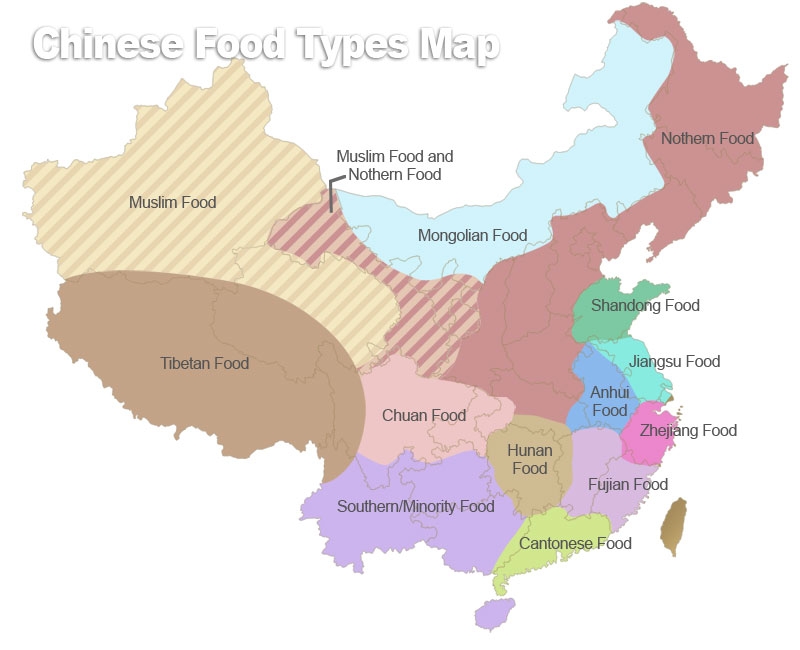Here's a view of China's cuisine regionality by what is eaten in the region, in this case as grains, noodles, dumplings and such as exhibited on Fast Co.
Not really useful and too geopolitical, but fun all the same.
You'll most often see China divided in 4 or 8 regions. Considering the numerology issues, the 4 is sort of surprising and the 8 is to be expected. 4 is traditionally a bad luck number associated with death and 8 is the luckiest of numbers. Neither the 4 nor the 8 divisions really cover most of China, just the most well known and categorized cuisines on the eastern side of the country with a little south-central addition as well.
However, there is a growing discussion of Chinese cuisine organized by region/Province and or Major City as well which gives the best granularity of variation and specialization. No organization of regionality is right or wrong. It depends on the goal of the discussion. You can follow trends at various levels to tie things together or differentiate them depending what you're trying to show as related or different.
As 4 regions
Chinese cooking as 4 regions is constructed by dividing the country into the Northern, Eastern, Southern and Western sections. This organization is the simplest . It doesn't cover the whole country, leaving the truly western chunk uncategorized as well as some of the North.
- Northern, or Beijing, or sometimes called Mandarin. Usually considered to include some of the Mongolian and Muslim influences as well.
- Eastern or Shanghai, often considered to use more oil and sweetening in the dishes.
- Southern or Sichuan, but also including Hunan style dishes
- Western or Cantonese, what we in the west are most familiar with. This is where stir frying is said to have reached its highest achievements and also dim sum.
Over at Redcook.net, there is a good critique of the 4 region classification, but also recognizes the limitations of the 8 regions.
As 8 Regions
Chinese Cooking as 8 regions is the most common organization I've encountered in cookbooks and on-line. There are more cultural distinctions added at this level of regional analysis. But it doesn't really cover the whole country either. The 8 region view focuses largely on the ethnic Han and ignores Tibet, Mongolia, and so on.
Note this agricultural region map from http://www.kas.ku.edu/archived-site/chinese_food/regional_cuisine.html and how it overlays the 8 regions
There's a correlation to the agricultural productivity and it being noted for distinct cuisine. Also note the heavy focus on the coast and primary river region extending through Hunan to Sichuan.
And also population density contributes to these classifications as well, clustering where the food production is to a large degree.
Covering the whole country
The ChinaHighlights map uses the 8 traditional cuisines, but adds in the other regions and names them as well. This is a pretty useful organization for chinese regional cuisine. Of note, it refers to the Chuan people, an area more familiar to the westerner as Sichuan.
They include linked explanations for the other regions they name that are useful and can be generally applied.
Other views of the regions
Regions have been determined more methodically by the Beijing Computational Science Research Center based around the contents of an extensive cooking website, meishij.net. As an English speaker and reader, access that site via Google Chrome so you can use the built-in translations. It will still be pretty hard to understand, but you'll understand some of it at least.
It shares a lot of similarities with the China Highlights map, but refines a few of the larger regions into new categories. You should read the entire article at The Atlantic on the topic.
Some useful links on the topic of Chinese Regional Cooking
- China ex-pats offer this explanation. They describe 14 regions but still drop out parts of the country like Tibet.
- ChinaCulture.org lists 17 cuisines of China with an overview of style and distinct dishes.
- An article by Jennifer 8 Lee about a Xi'an restaurant and its food in NYC.
- Another article about the Beijing Computational research.
- A good site about Tibetan food
- A CNN article for 31 Shanghai dishes.
Book list
I've read these books that concern themselves with regionality in Chinese Cuisine and find them useful to various degrees.
The Gourmet Chinese Regional Cookbook by Calvin Lee I own this as an ebook. It's pretty good to cook from, and the dishes are linked to a region. There's not a lot of insightful regional analysis.
Tibetan Cooking by Elizabeth Kelly, another ebook. I'm a little concerned by her willingness to use olive oil. It's very simple cooking and writing. I don't have much to compare it against and I have a hunch there's been quite a bit of adaptation and simplification for casual western cooks.
Cooking from China's Fujian Province by Jaqueline Newman. An ebook again. I'm quite impressed with this one and recommend it. You may well have some difficulty with finding hong zhao, wine sediment, but a recipe for a substitute is included.
Chinese Regional Cooking by Kenneth Lo. This is out of print, but you can get it at Alibris and other used book sellers. This works through restaurant recipes and other sources. Content is very traditional and not so much like what westerners tend to encounter.
Land of Plenty by Fuchsia Dunlop focuses on Sichuan cuisine. A good book with well tested recipes and explanations of ingredients and cuisine.
Revolutionary Chinese Cookbook by Fuchsia Dunlop focuses on Hunan Cuisine, the home of Chairman Mao. Again, excellent.
New Cantonese by Eileen Yin Fei Lo obviously focuses on contemporary Cantonese food and is a pleasing book to cook from.






No comments:
Post a Comment